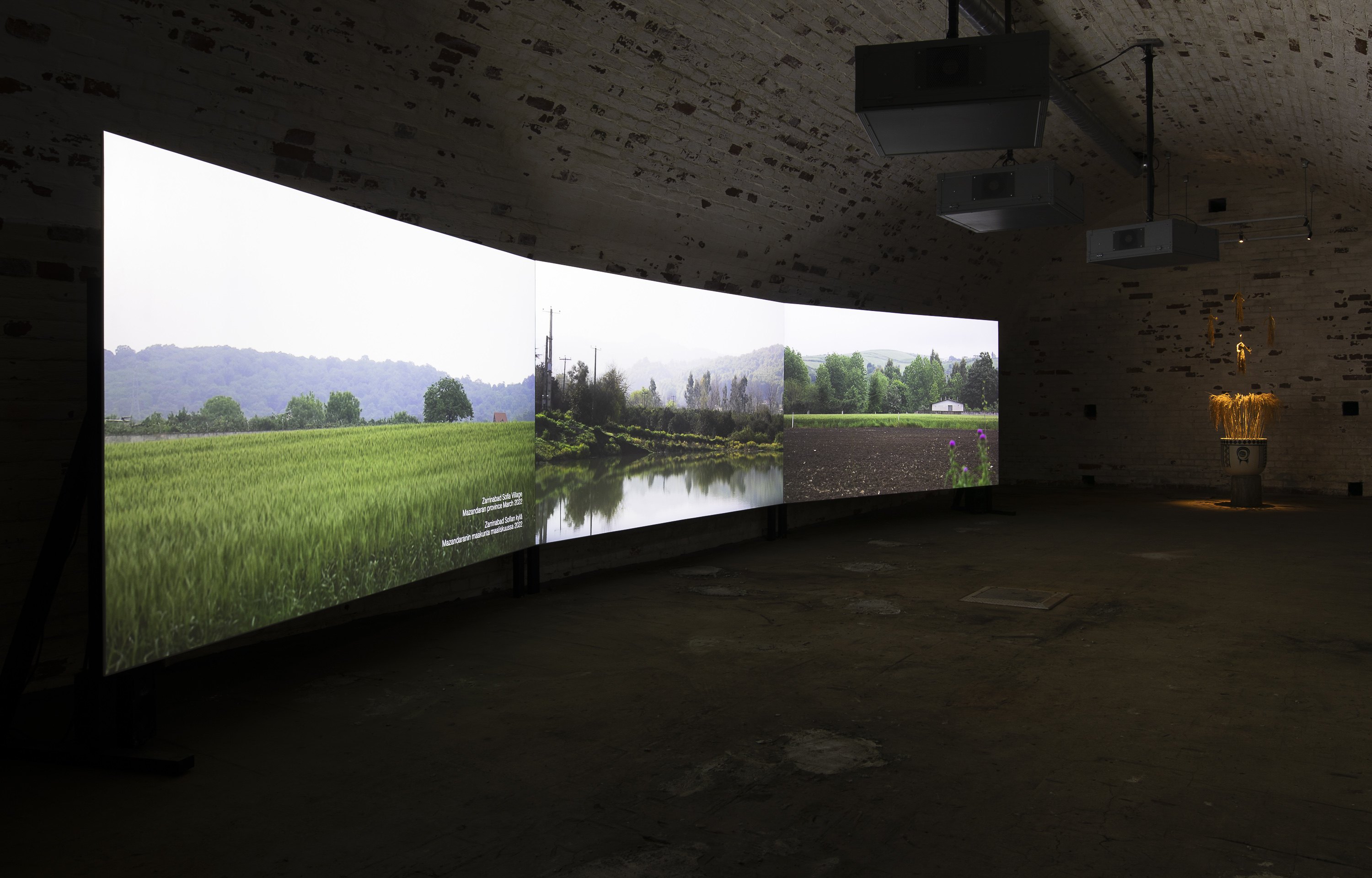Sepideh Rahaa is an Iranian-Finnish multidisciplinary artist and researcher based in Helsinki. She investigates and questions prevailing power structures, social norms, and conventions while focusing on womanhood, storytelling, and everyday resistances. Rahaa aims to initiate and create spaces for dialogue, influenced by feminist politics, decolonial and postcolonial theories and practices as well as social and environmental justice.
Helsinki Biennial 2023 presented Sepideh Rahaa’s installation comprising a multichannel video, Tarom Hashemi rice plants in a pot decorated with ancient natural elements of Iran-e-bastan, and handmade rice dolls. The work highlights issues of food security, access to clean water and nourishment as well as the importance of the traditions of sustainable cultivation in the current climate emergency. It brings to the fore the often invisible and inaccessible process of rice cultivation, the second most important staple food in the world.
She invites the audience to experience a process in which stories, water, paddy lands, rice grains and women’s labour – and their songs to the Earth and to the seeds – are intertwined with consumer life in our contemporary world.
The work’s visual narratives are interwoven with the local songs sung by women workers. The workers’ songs contain stories of their daily struggles in Mazani (one of the indigenous Iranian languages of the North) and are passed from grandmothers to mothers and daughters and sung during the cultivation and harvest seasons. The poetic piece connects cultures, languages, geographies, politics, and people through the portrayal of the process of labour and cultivation. It further hints at contemporary neo-colonial food politics and how Iranian farmers are forced by sanctions to use toxic chemical fertilizers, as well as the ongoing environmental crisis, in particular water shortages and soil contamination.
This project developed during a period when I needed to be healed deeply both in life and work. Ten years was a long time to be working and living with immigration. Returning to my childhood memories and to where my family and ancestors were located could be a remedy. It started with a conversation I had with myself, which then expanded to thinking and living together in the world. What does it mean to coexist, living far away or nearby? What visible and invisible linkages, connections and disconnections make this possible or real? Simple matters elsewhere make a difference here. We live relationally despite continental, political, societal, and geographical differences.
‘Songs to Earth, Songs to Seeds’ refers to the long and ritual process of rice cultivation in the paddy lands in Mazandaran, Northern Iran. The process is almost yearlong, from pre-springtime until mid-autumn. Cultivation of rice is an intergenerational heritage in my family and this knowledge has been circulated for nearly a century. My father inherited it from his father, who lived over a hundred years. I recall rice paddy lands with women working and singing, dancing, and resting; and my father, who has always worked hard, producing almost a ton of rice to feed several families, but rarely selling to others. I wanted to use this familial history in which women have a big part and expand it to our contemporary lives.
Sepideh Rahaa

Sepideh Rahaa: Songs to Earth, Songs to Seeds, 2023. © HAM/Helsinki Biennial/Kirsi Halkola
Rahaa’s work has been exhibited and screened in Europe, East and Southwest Asia: Iran, Taiwan, United Kingdom, Spain, France, Norway, Sweden, Estonia, Germany, Latvia, Lithuania and Finland, including venues such as Rauma Art Museum for the Rauma Triennale 2022, Artsi Art Museum 2021 and Pori Art Museum 2019.
She will soon exhibit both at Helsinki Biennial 2023 and Liverpool Biennial 2023.
Rahaa is an active member and co-founder of Third Space collective in Helsinki (2015-).
Sepideh Rahaa
Songs to Earth, Songs to Seeds
2023
installation (multichannel video, Tarom Hashemi rice plants in a pot decorated with ancient natural elements (of Iran-e-bastan), and handmade rice dolls)
Produced, written, and directed: Sepideh Rahaa
Camera: Sepideh Rahaa
Sound artist: Ana Gutieszca
Melodies and singing: Banoo
Music (Shevâr): Abolhasan Khoshru, Hoseyn Tayyebi and Nurollâh Alizâdeh composed by Ahmad Mohsenpur, Mahoor Institute of Culture and Arts
Main participants: Mohammad Sadati, Sakineh Sadati, Ghorban-Ali Dadashi and many women workers in the paddyland.
Performers: Hengameh R, Martta Tuomaala, Rosamaría Bolom and Ville Apell
Arrangements: Shoora Sadati, Fatemeh Sadati
Proofreading and text in Finnish: Ville Apell, Martta Tuomaala and Petronella Grönroos
Supported by Finnish Cultural Foundation & Arts Promotion Centre Finland
Special thanks to Rauma Triennial, Helsinki Biennial, Mahoor Institute of Culture and Arts, my family and all people who assisted in the production of the project.
Courtesy of the artist.